by John Holbrook Jr.
A Biblical View, Blog #072 posted December 24, 2018, edited March 10, 2021.
This blog began with an attempt to create a Christmas card. I searched for a drawing or painting that depicted the adoration of the newborn Yeshua (or Jesus) by either the shepherds or the Magi with both accuracy and artistic merit. Surprisingly, my search proved fruitless. What I did find, however, was a picture that I could use as a teaching tool.
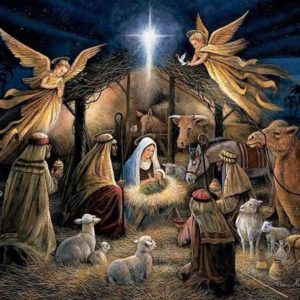
The picture shows the Magi in the manger with both angels and the Star of Bethlehem in the sky above. It is a nice composition, with the focus on mother and child despite the power of the star’s light. The painter’s warm tones create a pleasant and peaceful atmosphere which draws one into the scene. Unfortunately, the depiction is inaccurate. The Magi never visited the manger, and the star never stood in the sky over the manger.
Here is what really happened in the Middle East in late 2 BC.
1 – Events Surrounding the Birth of the Christ Child
1A – The Orchestration of the Planets
On August 27th, Jupiter (the Father) and Mars (the Warrior) conjoined, with Mercury (the Messenger) and Venus (the Mother) nearby. Together the four planets constituted what in astrological circles is known as a “massing of the planets” in the constellation Leo (the Lion). At the same time, the Sun was entering the constellation Virgo (the Virgin).
1B – The Annunciation to the Shepherds
On August 28th, which was Tishri 1, the start of the seventh month in the Jewish calendar, and which is called Rosh-Hashanah or the Day of Trumpets, a group of shepherds were tending their flocks by night in the fields outside Bethlehem. Suddenly, the Angel of the Lord appeared over their heads and announced, “Fear not, for, behold, I bring you tidings of great joy, which shall be to all people. For unto you is born this day in the City of David a Savior which is Christ the Lord. And this shall be a sign unto you. Ye shall find the babe wrapped in swaddling clothes, lying in a manger.” Then around him appeared “a multitude of the heavenly host, praising God….”[1]
1C – The Adoration of the Shepherds
Later on August 28th, the shepherds abandoned their flocks and went into Bethlehem to visit the newborn child, whom they found in the stable that was adjacent to an inn. On bended knee, they adored “the babe lying in a manger.” [2]
1D – The Home of the Holy Family in Bethlehem
Soon after the Christ Child’s birth, the Holy Family moved from the inn’s stable to a house elsewhere in the city.
1E – The Star of Bethlehem
During the next four months, Jupiter moved westward from the company of Mercury, Mars, and Venus to a position over Bethlehem, where it stopped for six days (roughly December 22nd to 28th) – having reached a stationary point between its progression and regression with respect to Earth. From the perspective of Jerusalem at dawn, the normal time for astronomical observations, Jupiter (then a morning star) would have occupied the meridian position at an elevation of 68 degrees above the southern horizon, which would have put it in the abdomen of Virgo (the Virgin) and directly over Bethlehem. In addition, the Sun reached the Winter Solstice on December 21/22 and therefore was also standing still in the sky.[3]
1F – The Adoration of the Magi
In the lands to the east of Israel, the Magi (or wisemen) traveled from their homelands in the east to Israel in the West. Armenian tradition indicates that there were three of them – possibly because they were bearing three gifts (gold, frankincense, and myrrh[4]) – and identifies them as Balthasar of Arabia, Melchior of Persia, and Gaspar of India
Initially the Magi traveled to Jerusalem, where they met with Herod.[5]
The Magi then traveled to Bethlehem, where they probably arrived on December 25, 2 BC. There they visited the home of the Holy Family, where they adored the Christ Child and laid their gifts at His feet.
2 – The Most Appropriate Scenes for Christmas Cards
Thus, in my view, the three scenes that are most appropriate for use at Christmas time are the following:
The Annunciation to the Shepherds on the evening of August 28, 2 BC, in which the Angel of the Lord appears to the shepherds who are tending their flocks in the fields outside Bethlehem. The angel is hovering just over their heads and proclaiming the good tidings of the birth of Jesus.[6]
The Adoration of the Shepherds later on the night of August 28, 2 BC, in which the shepherds on bended knees adore “the babe lying in a manger.” [7]
The Adoration of the Magi on December 25, 2 BC, in which the three Magi present their gifts to the Christ child in a domestic setting, with the Star of Bethlehem in the sky above the house and the wisemen bowing before Him.
Here are three portrayals of those scenes.
2A – Annunciation to the Shepherds
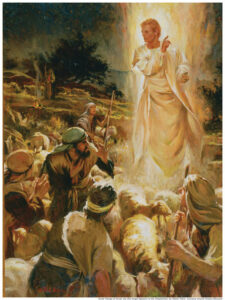
by Anonymous
2B – Adoration of the Shepherds
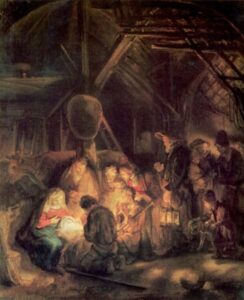
by Rembrandt van Rijn
Unfortunately, the shepherds are clothed in Dutch dress.
2C – Adoration of the Magi
I have not yet found a portrayal of the Magi in a domestic setting, but here are two illustrations that I find particularly pleasing. They show the Magi en route to Bethlehem. The first shows them accompanied by a retinue that would have been appropriate to important men bearing valuable gifts.
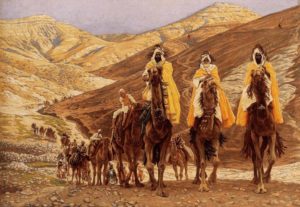
by Anonymous
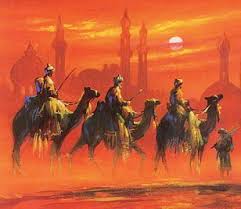
by Anonymous
If you find a portrayal of the Adoration of the Magi in a domestic setting, please let me know.
3- What is Christmas all about?
Since tomorrow will be Christmas, the day on which Christians celebrate the Birth of the Christ Child, I would be remiss if I did not pose and then answer the above question for the benefit of non-Christians who read this blog.
The Bible indicates that God created our first parents, Adam and Eve, and then placed them in an idyllic setting, the Garden of Eden, which met all their needs and allowed them to fellowship with God and one another in peace and comfort.
Soon thereafter, Adam and Eve disobeyed God, which had severe consequences. They became sinners, alienated them from God, and thereby ensured that all their descendants would be born sinners, also alienated from God – excepting one, whom God would someday send to Earth to repair the breach between God and Mankind. Then they were ejected from the Garden into a hostile world where the man would have difficulty providing protection and provision for his family, and the woman would suffer pain in giving birth to their children. In addition, henceforth they and all their descendents would experience physical aging, sickness, and death.
The above might be characterized as the Bible’s bad news and good news for all Mankind.
The Bad News: At birth,[8] everyone excepting the Christ Child is born with a live mind and a live body, but a dead spirit, of which he or she is unaware. Thus, everyone enters this world with a predilection to sin – i.e. to dishonor God and to disobey God’s commandments.[9] Moreover, a person cannot stop sinning or even recognize his or her own sinfulness – let alone provide atonement for his or her sins, which requires the sacrifice of an innocent, unblemished life. Because God is holy[10] and hates sin,[11] a person’s sinfulness and sinning separates him or her from God.[12]
The Good News: “…God so loved the world that he gave his only begotten Son, that whosoever believeth in Him should not perish, but have everlasting life” (KJ21 John 3:16). God sent his Son to Earth the first time[13] in the form of a tiny baby, who was named Yeshua (Jesus in English).[14] He was born in a manger in Bethlehem, lived a sinless life, died on a cross at Golgotha [15] to atone for the sins of His followers,[16] rose from the grave,[17] and ascended into Heaven,[18] where He sits on the Throne of God. God will send his Son to Earth a second time[19] in the form of a mighty warrior, the King of kings and Lord of lords, at the head of the Hosts of Heaven. He will remove His faithful followers[20] from Earth, wreak vengeance on an unbelieving and sinful world, and establish new heavens and a new Earth for His people, over whom He will reign forever.
When a person believes the Goods News, repents, and accepts Yeshua as his or her Savior and Lord, he or she experiences a second birth. His or her spirit awakens. As John Newton wrote in 1779, “I once was lost, but now am found; Was blind, but now I see” (Amazing Grace).
Dear reader, if you have not already done so, accept the free gift that God offers to every person, regardless of his or her age, appearance, behavior, education, ethnicity, intelligence, occupation, race, religion, reputation, sex, station, talents, or wealth. Your spiritual eyes and ears will be opened, and your heart will be filled with indescribable joy.
© 2018 John Holbrook Jr.
________________________________________
[1] Luke 2:8-13.
[2] Luke 2:16.
[3] Martin, Ernest, The Birth of Christ Recalculated, Foundation for Biblical Research, Pasadena, CA, 1980M, pp. 21-23.
[4] Matthew 2:11. These three gifts are highly symbolic. Gold is an appropriate gift for a king – in this case, the eternal King of Israel. Frankincense is an appropriate gift for a priest – in this case, the eternal High Priest of Israel. Myrrh is a substance used in burials – in this case, the burial of the incarnate God-the-Son in the tomb of Joseph of Arimathea after His perfect, one-time for all time sacrifice on the cross at Golgotha to atone for the sins of Mankind.
[5] I do not accept the normal date for Herod’s death. I argue as follows: (a) In 40 BC, which was 4 Augustus, Herod was appointed King of Judea by Augustus. Hence, 40 BC = 4 Augustus = 0 Herod. (Finnegan, Jack, Handbook of Biblical Chronology, Hendrickson Publishers, Peabody MA, orig. 1964, rev.1998, p. 230). (b) In 37 BC, which was 7 Augustus, Herod took Jerusalem. Hence, 37 BC = 7 Augustus = 3/0 Herod. (c) In either 5 BC or 3 BC, Herod appointed his son Antipater as co-regent (I prefer the former because there are indications that Antipater reigned for a total of 10 years, 5 as co-regent and 5 as king). Josephus appears to have erred in subtracting three years of this co-regency from Herod’s full reign, thereby arriving at a 37 year reign for Herod. He may have been influenced by the fact that, after the death of Antipater and Herod, Archelaus and Philip later claimed that their reigns had commenced at the same time as their brother Antipater’s co-regency. (d) After the Magi’s visited him, Herod issued his command that Jewish boys under the age of two be killed – the Slaughter of the Innocents (Matthew 2:16). (e) An eclipse of the moon occurred on the day on which Herod had a man named Matthias executed and another man named Matthias deprived of the position of High Priest. (f) Five days after the eclipse, Herod died (40 years from his appointment as king and 37 years from his investment of Jerusalem).
[6] Luke 2:8-14.
[7] Luke 2:16.
[8] Called the first birth.
[9] See Genesis 6:5, I Kings 8:46, Psalm 53:3, Proverbs 20:9, Isaiah 53:6 & 64:6, Romans 3:10-12 & 3:23, I John 1:8.
[10] Exodus 15:11, I Samuel 6:20, Psalm 99:9, Isaiah 6:3, Revelation 15:4.
[11] Deuteronomy 25:16, Psalm 11:5, Proverbs 6:16, Zechariah 8:17, Luke 16:15.
[12] Isaiah 59:2 & 64:7, Hosea 5:6.
[13] Called the First Advent.
[14] Yeshua of Nazareth is the Promised Messiah of Israel. The Hebrew prophets predicted His first coming, His rejection by the majority of His people to allow time for a number of Gentiles to enter His Kingdom, and then His second coming to make all things new.
[15] Golgotha is just outside Jerusalem, near the Damascus Gate.
[16] His Jewish followers make up the Faithful Remnant of Israel
[17] Called the Resurrection.
[18] Called the Ascension.
[19] Called the Second Advent or Parousia.
[20] God imputes his Son’s righteousness to his Son’s faithful followers. In Romans 11, His faithful followers are represented by the Cultivated Olive Tree. His Jewish followers are represented by the fruitful branches which remain in the tree after the fruitless branches have been pruned out and burned. His Gentile followers are represented by the branches that have been removed from the Wild Olive Tree and grafted into the Cultivated Olive Tree.
